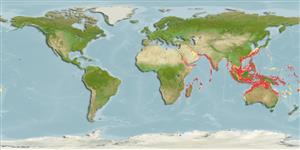Teleostei (teleosts) >
Pleuronectiformes (Flatfishes) >
Cynoglossidae (Tonguefishes) > Cynoglossinae
Etymology: Cynoglossus: Greek, kyon = dog + Greek, odous = teeth + Greek, glossa = tongue (Ref. 45335).
Eponymy: George François de Bruijn (or Bruyn) Kops (1820–1881) was a Dutch naval officer who was a friend of Peter Bleeker and who studied the geology, history and ethnography of the Riau Archipelago. (Ref. 128868), visit book page.
More on author: Bleeker.
Environment: milieu / climate zone / depth range / distribution range
Ecology
Marine; demersal; depth range 24 - 204 m (Ref. 9494). Tropical
Indo-West Pacific: Persian Gulf to Taiwan.
Size / Weight / Age
Maturity: Lm ? range ? - ? cm
Max length : 60.0 cm SL male/unsexed; (Ref. 48637)
Eyes contiguous, or nearly so (Ref 9895).
Inhabits silty or muddy substrates in coastal waters to about 25 meters depth. Usually deeply burried in the substrate during the day, but out and hunting at night (Ref. 48637).
Life cycle and mating behavior
Maturity | Reproduction | Spawning | Eggs | Fecundity | Larvae
Menon, A.G.K., 1977. A systematic monograph of the tongue soles of the genus Cynoglossus Hamilton-Buchanan (Pisces: Cynoglossidae). Smithson. Contrib. Zool. (238):1-129. (Ref. 5297)
IUCN Red List Status (Ref. 130435: Version 2024-2)
Threat to humans
Harmless
Human uses
Fisheries: of no interest
Tools
Special reports
Download XML
Internet sources
Estimates based on models
Preferred temperature (Ref.
123201): 20.5 - 28.1, mean 26 °C (based on 915 cells).
Phylogenetic diversity index (Ref.
82804): PD
50 = 0.5000 [Uniqueness, from 0.5 = low to 2.0 = high].
Bayesian length-weight: a=0.01047 (0.00432 - 0.02536), b=3.04 (2.83 - 3.25), in cm total length, based on LWR estimates for this (Sub)family-body shape (Ref.
93245).
Trophic level (Ref.
69278): 3.6 ±0.4 se; based on size and trophs of closest relatives
Resilience (Ref.
120179): Medium, minimum population doubling time 1.4 - 4.4 years (Preliminary K or Fecundity.).
Fishing Vulnerability (Ref.
59153): Moderate to high vulnerability (49 of 100).
